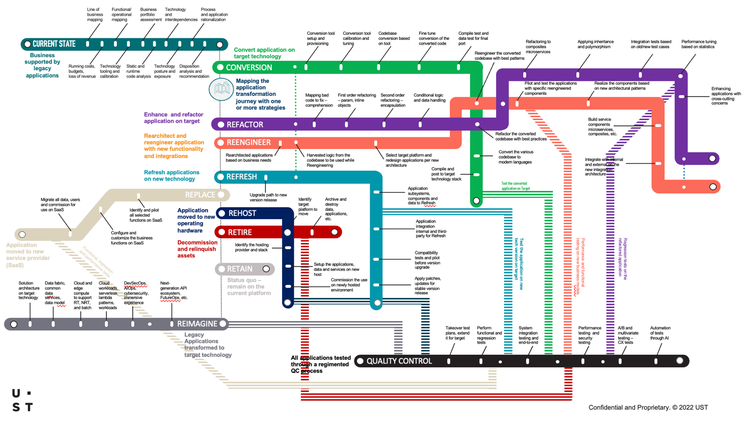

Insights
When and how to rearchitect applications for the cloud
Rajkumar Jeyaraj, Application Development for UST
Rearchitecting entails the most complex process with more steps than any other method.
Rajkumar Jeyaraj, Application Development for UST
There’s no doubt that new applications are increasingly being built to live in the cloud. But what about the legacy applications you already have?
Rearchitecting applications for the cloud enables you to hold onto the best parts of those applications while also adopting agile, scalable, and secure cloud-native features.
While many options exist for potential migration methods, rearchitecting is the one that creates a complete transformation, totally reimagining how legacy applications can be rebuilt and operated on the cloud. This approach enables clients to leverage the makeover to align with new business prospects and supplementary revenue streams.
Enterprises planning a cloud migration have much to consider — When is the right time? How will this truly drive value for my company? Is rearchitecting really the best solution for us?
These are all valid questions, and we’re here to answer them. Let’s dive in.
What is rearchitecting?
Rearchitecting (often referred to as refactoring) involves upgrading a current application to run better in a legacy environment.
Rearchitecting is the most expensive and the heaviest lift of all migration strategies (more on those shortly). Because of this, the decision to rearchitect is usually driven by a strong organizational need to be cloud-native, typically to increase agility and scalability to meet end-user needs better.
What other options are available?
There are other Rs for migrating applications to the cloud, but the terms often used interchangeably can be confusing. Let’s clarify what the other Rs entail (and how they’re different from rearchitecting).
- Reengineer: Rearchitect and reengineer application with new functionality and integrations.
- Refactor: Sometimes called rearchitecting, this approach involves upgrading a current application to run better in a legacy environment.
- Rehost: Sometimes called lift and shift, this approach involves moving an existing application from a legacy environment (such as an on-premises server) to newer infrastructure, such as a public Cloud platform with little to no changes to its underlying code or architecture.
- Replace: Remove the original application completely and create a new one built for the Cloud environment.
- Retire: Shut down existing code and commission and relinquish assets.
- Retain: Keeping an application in its current form, which sometimes makes the most sense, such as with cloud-incompatible legacy operating systems or compliance standards that require on-site data or perform well in their current form.
- Refresh: Upgrade path to new version release.
- Reimagine: Legacy application is transformed to target technology.
- Retool: Also called Conversion, this involves mapping an application transformation journey with one or more strategies.
The diagram below shows how the RS map against each other.

As you can see, of all cloud migration strategies, rearchitecting (refactoring on the visual) requires the most time, cost, effort, and skill. This means companies must think carefully about when rearchitecting is warranted and how to execute the migration process successfully.
Recognizing the right time to rearchitect
If your company is transitioning from a traditional monolithic architecture or looking to enhance features, scalability and overall performance in ways not supported by the application’s current environment, rearchitecting is likely your best option.
Rearchitecting entails the most complex process with more steps than any other method. But the benefits (when executed successfully) easily justify the investment.
Benefits of re-architecting applications for the cloud
- Supplementary business: Aligning the changes to business transformations provides clients to leverage the makeover to align with new business prospects and supplementary revenue streams.
- Reduced cost of ownership: Large applications run on legacy-based hardware infrastructure are expensive. Reducing large infrastructure costs is no small thing for companies considering rearchitecting applications for the cloud, where they can be more affordably operated and scaled.
- Increased agility and scalability: Cloud-native applications are highly adaptable by nature. When you migrate entire applications to the cloud, they automatically become more agile, thanks to microservices models that enable CI/CD pipelines and easily updated functionality to meet end-user needs.
- Better resilience: Monolithic applications are at risk of app-wide failure every time one component breaks. Cloud-native microservices isolate faults so that your applications are more resilient and can operate even as developers address bugs and other issues.
- Sophisticated security: It’s true that security can be complex for cloud-native applications, but when executed correctly, they also have important benefits such as better visibility and monitoring.
Challenges to consider
Rearchitecting does have challenges that should be carefully considered:
- Cost: While it’s true that rearchitecting yields cost savings over time, the initial financial investment is substantial.
- Expertise and experience: Rearchitecting requires high-level DevOps skills and expert code knowledge. Developer teams not versed in cloud-native practices will encounter frustration and likely make missteps that could adversely affect the process. Companies without the internal experience and expertise to execute should consider hiring consultants who can help.
- Time: Rearchitecting is not an overnight process. Companies with urgent migration needs may want to consider using other “R” methods for time-sensitive migrations rather than rushing the rearchitecting process.
Key takeaways
- Rearchitecting in consultation with the clients offers continuous business benefits.
- Rearchitecting transforms legacy applications to a modern cloud-native application.
- Rearchitecting applications for the cloud often require more time, effort, and investment than other methods and yield a bigger return on investment.
- Benefits of rearchitecting include more agility, scalability, increased resilience, better security, and reduced cost of ownership.
- Consultants can help companies without the internal rearchitecting process expertise and experience.
Migrate your applications with confidence
As you transform your traditional, stand-alone IT into an experience-centric business enabler, we help make the process swift and seamless. UST’s customizable approach has already helped clients move more than 8,000 applications to the cloud quickly and cost-effectively.
Ready to get started? Visit UST Cloud services today.